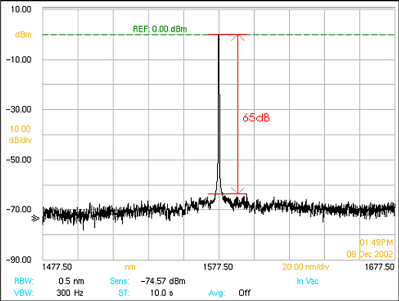Wavelength Tunable Diode Lasers KLS-601A Series (Tunable Diode Laser:High Resolution Model)
Wavelength Tunable Diode Lasers
KLS-601A Series
High-resolution model that achieves 0.0001nm(=0.1pm) of wavelength resolution
Specifications
| Model | 1220 | O | ES | SC | CL | U |
| Wavelength range | 1180-1270nm |
1260-1370nm
|
1400-1530nm
|
1460-1570nm
|
1525-1630nm
|
1620-1680nm
|
| Optical Output*1 | ≧+3dbm | ≧+3dbm | ≧+3dbm | ≧+3dbm | ≧+3dbm | ≧0dbm |
| wavelength set resolution |
≦0.1pm
|
|||||
|
Wavelength accuracy |
≦±15pm(Min.:≦±5pm)
|
|||||
| Wavelength Precision |
≦±5pm(Min.:≦±1pm)
|
|||||
| Spectraum linewidth(Typical) | ≦100KHz |
≦50KHz
|
||||
| RIN(Typical) |
≦-145dB/Hz
|
|||||
| Optical output flatness(Typical) |
≦±0.2dB(APS function:ON)
|
|||||
| Optical output stability |
≦±0.03dB(60min.)
|
|||||
| Frequency stability |
≦±100MHz(60min.)=±0.8pm(wavelength stability)
|
|||||
| Optical output variation |
Available(Mas. power~-30dBm:set resolution 0.01dB)
|
|||||
| Optical output monitoring | Available(on the display) | |||||
| Internal low frequency modulation |
Available(Coherence control)
|
|||||
| Beam shutter | Available | |||||
| Output optical fiber | Polarization maintaining fiber | |||||
| Polarization |
Linear, aligned to the direction of connector key, Extinction ration≧20dB(Typical)
|
|||||
| Dimensions |
340W×450D×145H
|
|||||
※1: Highter output power is available depending on the model.
※2: The contents is subject to change without notice.
Features
■ by using laser beam with high purity and low noise
Spectral characteristics of optical components or other applied products can be measured with high dynamic range.
■ Taking advantage of low noise
Since the RIN characteristic is very good and does not affect the characteristics of the object under test, it is ideal as a light source for measuring the noise figure (NF) of optical fiber amplifiers (EDFA, etc.).
※RIN, Relative Intensity Noise, is an index of the intensity noise generated by the semiconductor laser itself, and is the ratio of the optical intensity noise (fluctuation of optical intensity) per unit frequency to the average optical output. When measured at the same optical output, the RIN value deteriorates as the noise increases. In order to reliably detect signals in optical communications, it is necessary to reduce the noise level, which is the fluctuation of the output light of the laser light source.
■Taking advantages of narrow spectrum linewidth and high short-term frequency stability
The spectrum linewidth is very narrow, less than 30 kHz, and the frequency is stable, which makes it ideal for measurement using optical beats.
※The spectrum linewidth indicates the spread of wavelengths, and the narrower the linewidth, the higher the single of wavelength. In the case of lasers, the fluctuation of the oscillation frequency due to various fluctuations is the spectrum line width. In optical communications, it is necessary to reduce the spectrum linewidth, which is the temporal fluctuation of the laser oscillation spectrum, in order to reduce noise characteristics during signal transmission.
※Because this is the measurement by the delayed self-heterodyne method, the spectrum has a frequency spread twice as wide as that of the actual measured light. Therefore, the linewidth value is 1/2 of the displayed value.
Applications
■High dynamic range measurement that cannot be achieved with a spectrum analyzer
- The GP-IB interface makes it easy to perform measurements in conjunction with a PC or a power meter.
- It can measure optical modules, etc. with a high dynamic range that cannot be achieved with a spectrum analyzer.
- The external output trigger is equipped, which enables synchronized measurement with other measuring instruments.
■ As a light source for optical fiber sensing
The excellent optical characteristics of low noise, narrow linewidth, and high stability make it ideal as a light source for optical fiber sensing.






